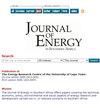Electric energy planning in Namibe, Angola: Inserting renewable energies in search of a sustainable energy mix
IF 0.6
4区 工程技术
Q4 ENERGY & FUELS
引用次数: 2
Abstract
The socioeconomic development of any region requires electricity for operating the various sectors of the economy. Sometimes energy is scarce, not only because of the lack of energy resources, but also because energy policy is inadequate or non-existent. This paper examines the situation in the province of Namibe, Angola, characterising the energy sector, and proposing an energy mix for the security of electricity supply, environmental protection and sustainable economic development. Using the Long-range Energy Alternative and Planning System, energy scenarios were simulated and the greenhouse gas emissions (GHGs) for the period 2014-2040 calculated and analysed. The most sustainable scenario, in terms of energy mix diversification and GHG reduction, as well as the least costly (considering electricity production and carbon costs), has an increase of hydro capacity and the insertion of wind, solar photovoltaic, thermoelectric sources and natural gas. Given the intermittency of photovoltaic and wind systems, natural gas appears in this scenario as a way to avoid interruptions in the electricity supply. This scenario is the one with the largest production reserve margin of 24.47 %, and emissions are avoided at 386 550 tCO2eq compared to the base scenario in 2040. Energy policymakers can take this scenario as a model to assist in making decisions on how power capacities can be installed over the planned time for the desired energy output.安哥拉纳米贝的电力能源规划:利用可再生能源寻求可持续的能源结构
任何地区的社会经济发展都需要电力来运行各个经济部门。有时能源是稀缺的,这不仅是因为缺乏能源资源,而且还因为能源政策不充分或不存在。本文考察了安哥拉纳米贝省的情况,描述了能源部门的特征,并提出了一种电力供应安全、环境保护和可持续经济发展的能源组合。利用远程能源替代和规划系统,对能源情景进行了模拟,并对2014-2040年的温室气体排放进行了计算和分析。就能源结构多样化和减少温室气体而言,最可持续的方案以及成本最低的方案(考虑到电力生产和碳成本)是增加水力发电能力和使用风能、太阳能光伏、热电源和天然气。考虑到光伏和风能系统的间歇性,天然气作为一种避免电力供应中断的方式出现在这种情况下。该情景具有最大的生产储量边际24.47%,与2040年的基本情景相比,可避免的排放量为386 550吨二氧化碳当量。能源政策制定者可以将此情景作为一个模型,以帮助制定在计划时间内如何安装电力容量以实现期望的能源输出的决策。
本文章由计算机程序翻译,如有差异,请以英文原文为准。
求助全文
约1分钟内获得全文
求助全文
来源期刊

Journal of Energy in Southern Africa
ENERGY & FUELS-
CiteScore
3.00
自引率
0.00%
发文量
16
审稿时长
6 months
期刊介绍:
The journal has a regional focus on southern Africa. Manuscripts that are accepted for consideration to publish in the journal must address energy issues in southern Africa or have a clear component relevant to southern Africa, including research that was set-up or designed in the region. The southern African region is considered to be constituted by the following fifteen (15) countries: Angola, Botswana, Democratic Republic of Congo, Lesotho, Malawi, Madagascar, Mauritius, Mozambique, Namibia, Seychelles, South Africa, Swaziland, Tanzania, Zambia and Zimbabwe.
Within this broad field of energy research, topics of particular interest include energy efficiency, modelling, renewable energy, poverty, sustainable development, climate change mitigation, energy security, energy policy, energy governance, markets, technology and innovation.
 求助内容:
求助内容: 应助结果提醒方式:
应助结果提醒方式:


